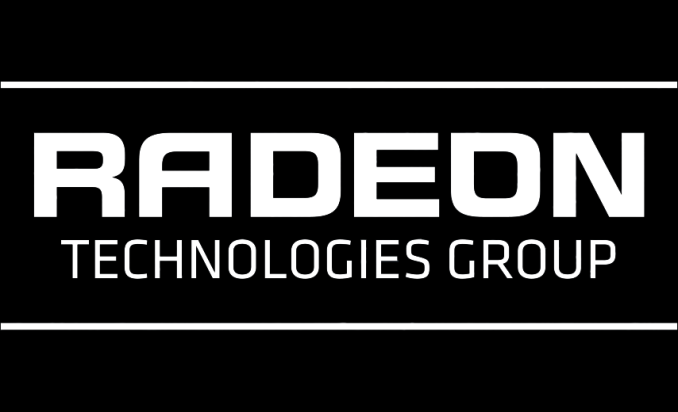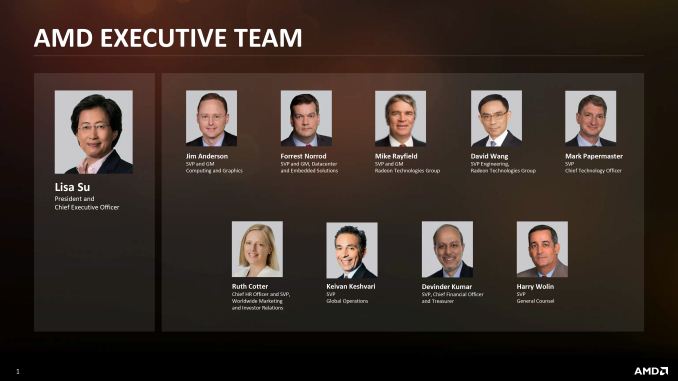AMD Reassembles the Radeon Technologies Group: New Leadership Hired & Semi-Custom Folded Into RTG
by Ryan Smith on January 23, 2018 5:00 PM EST- Posted in
- GPUs
- AMD
- Radeon
- Radeon Technologies Group

Ever since Raja Koduri abdicated his leadership post at AMD’s Radeon Technologies Group in favor of a similar post at Intel, the big question on everyone’s mind has been what would become of the RTG and who would lead it. While AMD – and ATI before it – is far from a stranger to graphics, the formation of the RTG in 2015 marked an important point in the development of AMD’s graphics business, as it was finally re-made whole under the AMD umbrella. As a business-within-a-business, RTG was largely seen as Raja’s baby, so his departure was destined to have a large impact.
Now just a bit over two months later, we finally know the fate of RTG. Today AMD is announcing the new leadership for RTG, bringing on two new Senior Vice Presidents to run the division. Meanwhile the company is also making some organizational changes to RTG, which although will keep RTG intact as a singular entity, will see it internally organized into dedicated engineering and business teams, each in turn reporting to their respective SVP heads. This change means that RTG doesn’t have a true, singular leader – not that Raja had full overview over RTG’s business operations, I’m being told – but rather both of the new SVPs report to AMD’s CEO, Dr. Lisa Su, and together represent the business unit.
Finally, while in the process of reorganizing and rebuilding the leadership of the RTG, AMD is announcing that they have also reassigned the semi-custom business unit. Semi-custom is now being folded into the business side of RTG, and while AMD’s announcement doesn’t note that there are any changes in how the semi-custom unit will operate, it will fall under the purview of the head of RTG’s business group.
RTG Engineering Group Leadership: David Wang, Senior Vice President of Engineering
First off then, let’s talk about the engineering side. The new head of RTG’s engineering efforts (and arguably the de-facto successor to Raja) will be David Wang. Wang is a name that some long-time followers may be familiar with, as until earlier this decade he was a long-term AMD employee that rose through the ranks to become a Corporate Vice President of AMD’s GPU and SoC efforts. And as you might expect for someone hired for AMD’s top GPU engineering post, Wang has a long history in the graphics industry, working for SGI before joining ArtX and going through the ArtX-to-ATI-to-AMD acquisition chain. Specific to his experience at AMD, Wang has worked on every AMD GPU between the R300 and the Southern Islands (GCN 1.0) family, so he’s seen the full spectrum over at AMD.
More recently, he’s been serving as the Senior VP of Synaptics, where he was one of several former ATI/AMD employees to jump ship over there around the turn of the decade. So for David Wang, in a sense this is coming back home to AMD. Which off the top of my head makes him the third such high profile engineer to jump out and back in over the last decade, after Raja Koduri and CPU guru Jim Keller.
Wang re-joins AMD at a critical time for its engineering group. With the Vega launch behind it, RTG’s engineering staff is in the middle of development of the Navi GPU architecture and beyond, all the while putting the finishing touches on Vega Mobile for this year and squeezing in a 7nm Vega design for servers for 2019. Vega’s launch has been a contentious one – for engineering reasons as much or more so than business reasons – so Wang may very well be a much-needed breath of fresh air for RTG’s engineering teams.
Officially, AMD is stating that in his position, Wang will be responsible for “graphics engineering, including technical strategy, architecture, hardware and software for AMD graphics products,” the last item in particular being notable, as this confirms that software is staying under the control of the engineering group rather than being more distributed through AMD as it once was.
RTG Business Group Leadership: Mike Rayfield, Senior Vice President and General Manager
David Wang’s counterpart on the business side of matters will be Mike Rayfield, who is being tapped to serve as the Senior VP and the General Manager of the business group. Rayfield is another industry veteran, albeit one without the same immense GPU history of Wang. Instead Rayfield’s history includes posts such as the VP and General Manager of NVIDIA’s mobile business unit (Tegra) and a director of business development at Cisco. Most recently (and for the past 5 years), Rayfield has been at Micron serving as the memory manufacturer’s VP and GM for their mobile business unit, which houses Micron’s mobile-focused memory and storage product groups.
AMD notes that Rayfield has “30 years of technology industry experience, including a deep understanding of how to grow a business and drive results,” which says a lot about AMD’s direction in very few words. Instead of hiring another GPU insider for the post, AMD is bringing in someone from outside the industry altogether, someone who has plenty of experience with managing a growing business. RTG’s business struggles are of course well-known at this point, so this offers AMD the chance to reset matters and to try to fully righten the conflicted business unit.
Rayfield is definitely joining RTG and AMD at an interesting time. On the business side of matters RTG is contending with the fact that Vega (and practically every other GPU AMD makes) is proving incredibly popular with cryptocurrency mining groups, to the point that, above the entry-level market, the North American consumer market has been entirely depleted of AMD-based video cards. In the short term this means that AMD is selling everything they can make, but Rayfield will have to help AMD grapple with the long-term effects of this shift, and how to keep the newly minted mining customers happy without further losing disillusioned gaming customers.
AMD Semi-Custom Folded Into RTG
Meanwhile along with overseeing the traditional business aspects of the GPU group, Rayfield is also inheriting a second job, overseeing AMD’s semi-custom business unit. Previously a part of the Enterprise & Embedded unit, semi-custom is being moved under the business side of RTG, putting it under Rayfield’s control. This reorganization, in turn, will see the Enterprise & Embedded unit separated from semi-custom to become the new Datacenter and Embedded Solutions Business Group, which will continue to be operated by SVP and GM Forrest Norrod.
Truth be told I’m still not 100% sure what to make of this change. AMD’s semi-custom focus was a big deal a few years back, and while the business has done well for itself, the focus at the company seems to have shifted back to selling processors directly, built on the back of the technological and sales success of the Zen architecture and its derivative products. Meanwhile, AMD is citing the fact that graphics is a core part of semi-custom designs as the rationale for putting it under the RTG. AMD still believes that the semi-custom business is more than just providing processors to the game console industry, but I do think that after a few years of pursuing this route, that this is the realization that game consoles are going to remain the predominant semi-custom customer. So in this respect it’s a bit of a return to status quo: game consoles are now once again part of the graphics business. And in the meantime semi-custom has certainly become a lower priority for AMD, as it’s a very regular in volume but relatively low in gross margin business for the company compared to their increasing CPU fortunes.
Finally, speaking of finances, it’s worth noting that AMD is calling this an increase in the company’s investment in RTG. The company isn’t throwing around any hard numbers right now, but it sounds like overall the RTG budget has been increased. AMD has of course struggled mightily in this area as a consequence of their lean years – in particular, it seems like AMD can’t complete as many GPU die designs per year as they once did – so combined with the shift in leadership, I’m optimistic that this means that we’re going to see AMD shift to an even more competitive position in the GPU marketplace.
Source: AMD













50 Comments
View All Comments
RandSec - Tuesday, January 23, 2018 - link
Consoles are single-chip for lowest cost. Intel does not have competitive graphics technology and Nvidia does not have an x86 processor. AMD does.HStewart - Tuesday, January 23, 2018 - link
But the Xbox 360 was not x86 based - it does not matter - it whom ever gives Microsoft the cheapest quality.RandSec - Tuesday, January 23, 2018 - link
A fundamental equipment change starts a new gaming generation, and at that time there are few games for the new equipment to run and so few reasons for gamers to buy that equipment.At the start of a new gaming generation, there also is no installed base, so not many game sales are possible or expected. That means there is little urgency to write games for the new equipment, so the situation is slow to turn around.
All of which means there is considerable interest from both hardware and software producers in extending the current generation with compatible designs. That means x86.
Manch - Wednesday, January 24, 2018 - link
The 360 had a custom Power PC and an ATI GPU.Ease of porting between the current gen and PC's (Win 10 based) lowers costs. Backwards compatibility which requires a good bit of work for MS, is lessened by keeping things x86/direct X based. I doubt we will see consoles diverge from the x86 platform again. portables are a different story....for now.
mode_13h - Tuesday, January 23, 2018 - link
I sure hope they learned from Vega that power efficiency has to be their #1, #2, and #3 priorities. I wonder if Lisa has been giving Navi the same TLC she gave to Zen.Post-Navi, I think we're due a ground-up redesign. GCN was a step forward, but it's getting a bit long in the tooth. It had some simplicity and elegance in the same ways as Bulldozer, but I'm doubtful of how much more tuning potential it has, and they can't get where they need to go by merely tweaking around the margins and reaping the benefits of process improvements.
KenLuskin - Tuesday, January 23, 2018 - link
1) A mistake by author who writes: "AMD is bringing in someone from outside the industry altogether". This is NOT true! Per Mike Rayfield's Linkedin page: 2005-2012 General Manager, Mobile Business Unit, NvidiaRayfield is NOT from outside the GPU industry at all. He worked for AMD's direct competitor for 7 years.
2) Semi-custom is still an important area for AMD, because the GPU deal with Intel was structured as a Semi-custom deal.
GPUs are the key differentiating IP that AMD will use to take away massive amounts of market share from Intel over the next few years
Ryan Smith - Tuesday, January 23, 2018 - link
Rayfield may have worked at NVIDIA, but his job there was overseeing the SoC business, not the GPU business. For the purposes of both GPU architectural development and selling discrete GPUs, he's very much an outsider. Which in this case is likely a good thing for AMD.HStewart - Tuesday, January 23, 2018 - link
"AMD Reassembles the Radeon Technologies Group: New Leadership Hired"Also call re-organization.
ET - Wednesday, January 24, 2018 - link
The Intel-AMD CPU's are a semi-custom graphics only solution, and I think that's one reason semi-custom is being folded into RTG: there is no semi-custom that doesn't include a GPU element (far as I know) but there is semi-custom that doesn't include a CPU element.mikato - Sunday, January 28, 2018 - link
That’s how I interpret it too. It isn’t consoles-only basically as the article said.